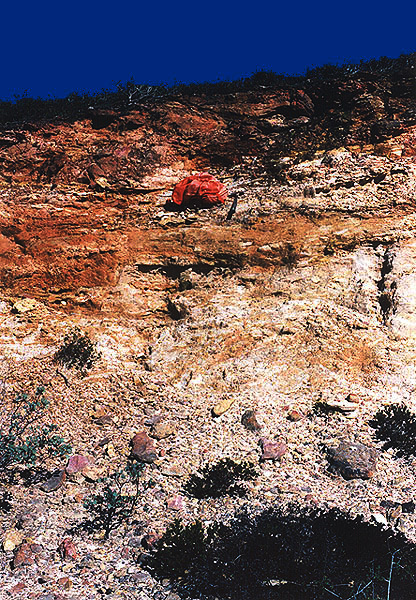
|
This is the second major fossil plant discovery I made in the Middle Eocene Ione Formation of the Ione Basin, California. The red backpack marks the precise position of the fossiliferous horizon here; the fossil horizon is a brownish to brilliant white feldspar-rich shale representing a humid, subtropical floodplain deposit. I found this particular site on June 19, 1992. Here is a quote from my field notebook on that day: "6/19/92--8:41pm--Friday: Another fantastic Eureka! day! I found another fossil leaf horizon, actually two of them. The fossil leaves come from two narrow sandstone layers in the Ione Formation, which has been ripped open to explore the lignite. Actually, I am not sure whether the leaves are Eocene in geologic age--there appear to be species of willow present of a type similar to those I have observed from Miocene formations in west-central Nevada. I am elated over this discovery--simply ecstatic. It is another classic fossil hunting outing, although when I headed out this late morning I really wasn't thinking about a serious opportunity to find leaves. I figured I'd poke around in the dumps of lignite for possible fossil leaves, but I hadn't given much consideration to to the idea that I might actually locate the plant specimens. Because it has been my experience that the lignites, low grade coal, were lacking in identifiable plants. So it was a tremendous serendipitous discovery of the fossil leaves in the younger sandstones of the sedimentary formation, an horizon possibly correlative with the locality I found on July 21, 1991 (the discovery site). The lithologies of the matrixes are very similar. I have not yet compared the floras from the sites, though, to determine if there is a recognizable relationship between the two." Note that I am still confused about the actual age of the strata. I am slowly coming around to the realization that the fossils in the Ione Basin come from the Middle Eocene Ione Formation, but am still holding out for the possibility of a younger geologic age. A few months later, on September 22, 1992, I received a letter from paleobotanist Dr. Daniel I. Axelrod, who had responded to my request to identify one of those willow-like leaf specimens I had mailed to him. Here is a quote from my field notebook on that day: "9/22/92--3:52pm--Tuesday: Hurray! Today, I received my reply from Dr. D. I. Axelrod of the university of California, Davis. I had mailed to him a fossil leaf specimen collected at the site I visited on June 19, 1992. He identified the fossil as an oak, Quercus simulata, a species that is extinct, 'as far as modern affinities;' the matrix he referred to the Miocene Valley Springs Formation, 21 to 22 million years old. So, my fossil flora comes from the Valley Springs Formation. I am surprised. I thought that the fossiliferous rocks might actually belong to the Mehrten Formation, but that geologic rock unit is only 10 to 7 million years old, so it is obviously too young. The Quercus simulata oak is typical of Middle Miocene-age in this part of the western United States. The locality is certainly of paleobotanical importance. The Valley Springs Formation is not known to be an exceptionally fossiliferous strata; as presently understood, it has only yielded a small flora from three or four widely separated sites. Axelrod ought to know, I suppose. He is an acknowledged expert on Mio-Pliocene floras in the Great Basin, California and Oregon, where he has collected extensively. Sometimes his conclusions are suspect, but it is indisputable that he has mastered the monograph form of composition." Of course, Dr. Axelrod turned out to be wrong about the identification of that fossil leaf I had sent him--also, he had misidentified the matrix upon which the specimen had been preserved. What looked to "Axe" to be a rhyolite tuff , characteristic of the Miocene Valley Springs Formation, was in reality a feldspar-rich chunk of shale, which is a very common and typical lithology one finds throughout the Middle Eocene Ione Formation of the Ione Basin. Please note: All fossil localities in the Ione Formation of Amador County, California, presently occur on private property; explicit permission from the land owners must be secured before collecting fossils there. |